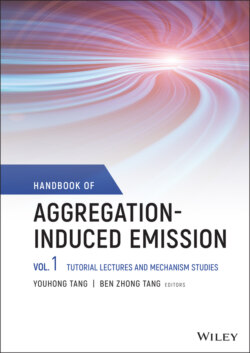Читать книгу Handbook of Aggregation-Induced Emission, Volume 1 - Группа авторов - Страница 38
2.3.5 Twisting Vibration of Molecular Skeletons
ОглавлениеCoumarin (chromen‐2‐one) is a natural organic substance that is abundant in many plants. CD‐7 (Figure 2.3) is a coumarin derivative with a seven‐membered aliphatic ring; it has typical AIE characteristics, while its analogue with a five‐membered aliphatic ring (CD‐5; Figure 2.3) exhibited an opposite ACQ effect [44]. The electronic structures in S0 and S1 at the level of (TD) M062X/6‐31G* were performed. The structural changes between S0 and S1 of CD‐7 are obvious. During the transition process from S0 to S1, the mean torsion angle between the pyridinone and chromen‐2‐one fragments changes about 18°, indicating that CD‐7 undergoes out‐of‐plane twisting motions along the C1–C2 bond under photoexcitation, while the corresponding geometric changes in the solid phase are only 5.8°, which suggests that the intramolecular twisting motion is largely restricted. In sharp contrast, CD‐5 has a more planar conformation of the conjugated framework in both the S0 and S1 and changes little in the gas phase, indicating its intrinsic structural rigidity. In addition, λtotal of CD‐7 reduced from 4028 cm−1 in solution to 3438 cm−1 in aggregates, owing to the restriction of twisting motion in aggregates. Thus, the restriction of twisting motion in aggregates blocks the nonradiative decay channels and enables CD‐7 to fluoresce strongly (see Figure 2.2f) [44].
Table 2.3 Calculation structural parameters of COTh [43] in both gas phase and the crystal (in degree).
| S0 | S1 | ∣∆(S0 − S1)∣ | S0 | S1 | ∣∆(S0 − S1)∣ | Crystal | |
|---|---|---|---|---|---|---|---|
| In gas phase | In solid phase | ||||||
| Θ I–II | 44.93 | 22.11 | 22.82 | 43.84 | 31.06 | 12.78 | 42.85 |
| Θ II–III | −48.58 | −24.36 | 24.22 | −48.67 | −35.71 | 12.96 | −48.83 |
| Θ III–IV | 44.92 | 22.11 | 22.81 | 45.24 | 32.60 | 12.64 | 45.16 |
| Θ I–IV | −48.59 | −24.36 | 24.23 | −48.94 | −35.72 | 13.22 | −46.99 |
THBDBA contains two pairs of phenyl rings that are covalently linked through a singly bonded ethyl chain (Figure 2.3); it is almost nonemissive when fully solvated in the THF solution and starts to emit with the addition of water [9]. In THBDBA crystal, each set of phenyl rings locked by the ethyl chain adopts a V‐shaped or “boat” conformation. Theoretical calculation indicates that the single molecule has a λtotal of 6898.6 cm−1, whereas the molecule in a cluster only has 5901.5 cm−1. The normal mode analysis shows that low‐frequency vibrational modes mainly contribute to λtotal for both single molecule and in crystal, but λtotal in the crystal is largely reduced. Upon aggregation, the restriction of low‐frequency twisting motion blocks the nonradiative decay channel and turns the fluorescence on (Figure 2.2g) [9].
